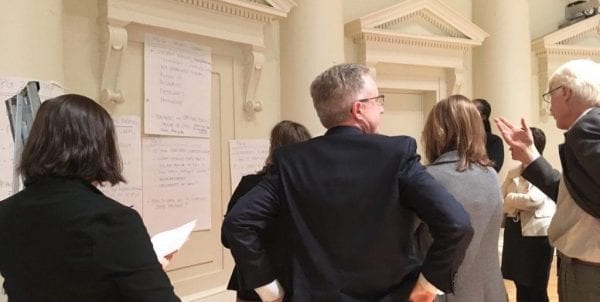DEVELOPING A JOINT RESEARCH AGENDA: WHAT QUESTIONS REMAIN?
By Paula Arce-Trigatti | NNERPP

In 2017, I had the privilege to attend a convening of NNERPP’s then newest member, the Tennessee Education Research Alliance (TERA), to discuss, develop, and refine a research agenda specifically tied to one of TERA’s priority research topics: “Reimagining State Support for Professional Learning.” TERA is one of the first research-practice partnerships of its kind, bringing together a state education agency (in this case, the Tennessee Department of Education) and a research institution (Vanderbilt University in Nashville, Tennessee). While this progression in the RPP world is uniquely exciting, the event itself was thrilling for me personally as it afforded the opportunity to witness the development of a joint research agenda in action. Although I have heard about the procedures used by some of our partnerships to lay out upcoming plans (see, for example, here), as with many things in life, there is no substitute for first-hand experience. Here I share some of my key takeaways from the meeting, along with several remaining unanswered questions for us to collectively think about as we continue to navigate through these domains.
(1) It’s important to have small, targeted discussions that include multiple viewpoints and a variety of stakeholders.
Approximately 50 people attended the convening, consisting of internal (to Vanderbilt) and external researchers, teachers and practitioners from around the state, and policymakers from the Tennessee Department of Education. This larger group was then broken up into smaller teams of around 8 people featuring folks from each of these units, which were then led through brainstorming, discussions, and decisions.
I had the chance to serve as a facilitator in a few of the breakouts, and can speak first-hand about the importance of having these smaller, diverse working groups tackle specific deliverables. For example, our first task during the meeting was to identify problems of practice around professional learning in Tennessee. Each member of the team brought very specific expertise to the exercise: teachers and practitioners spoke to what was happening in classrooms, policymakers shared intentions or goals behind related policies, and researchers described findings or theories to shape the conversation further. Additionally, because there was diversity in viewpoints (i.e., teachers came from multiple grade levels and practitioners included principals), the complexity of problems were more fully represented. I was amazed at the depth of conversation that took place with folks that had only known each other for about 30 minutes!
(2) Did I mention multiple viewpoints? Specifically, teachers are key.
I think the importance of having teachers actively participate in the conversation cannot be underscored enough. They bring much insight to the discussion, especially because they are closest to the learning (with the exception of the students, which raises questions about what their roles might be in this as well…). Teachers will additionally be instrumental in any post-research implementation that occurs. Having regular, open lines of communications with them will most likely improve support for these efforts.
3) What happens after the meeting is over?
After such a fantastically executed meeting leading to a virtual treasure trove of research questions and projects, TERA had their hands full prioritizing and completing the work. In the meantime, I offer the following questions for us to consider.
–How do RPPs keep practitioners engaged long after the meeting?
I heard many teachers/practitioners in attendance express gratitude and enjoyment at being included in the research agenda development process. They additionally worried, though, that this inclusion was a “one-time” deal.
How can RPPs maintain meaningful connections with practitioners, when the group of practitioners includes the entire state, in this case? How often should communications go out to them? What channels are best to not fall off their radars? Is the answer different for teachers versus principals?
–What is the role of external researchers that are not specifically a part of the RPP and when should their collaboration begin?
Several RPPs in our network (see here and here, for example) leverage expertise from outside researchers in order to expand capacity.
What is the best way for RPPs to take full advantage of these extra teammates? Can anyone join the external team or should it be limited to those participating in current networks? At what point in the existence of the RPP should they be included? What resources are needed to facilitate this type of collaboration? How should alignment with the research agenda be maintained?
–What communications around the research agenda are important and to whom is it important?
This is a question, but perhaps it really falls under a recommendation. I find that posting a research agenda on the partnership website is very useful, especially for those interested in learning more about the research being conducted at the RPP (see here, here, and here, for example). Not only does it help organize the publications and policy briefs that will surely follow the research, it can potentially spark connections with others interested in doing work in similar areas. Furthermore, it provides a small level of accountability for the partnership to demonstrate their progress to external stakeholders.
Conclusions
I had a wonderful time at the TERA convening, making new friends but also being granted a tremendous learning opportunity to better understand how developing a joint research agenda within an RPP works in practice. Going forward, my hope is that I am able to participate in more of these — learning by doing is an irreplaceable teacher and I would love to be able share the knowledge with all of you.
NNERPP | EXTRA is a quarterly magazine produced by the National Network of Education Research-Practice Partnerships | nnerpp.rice.edu